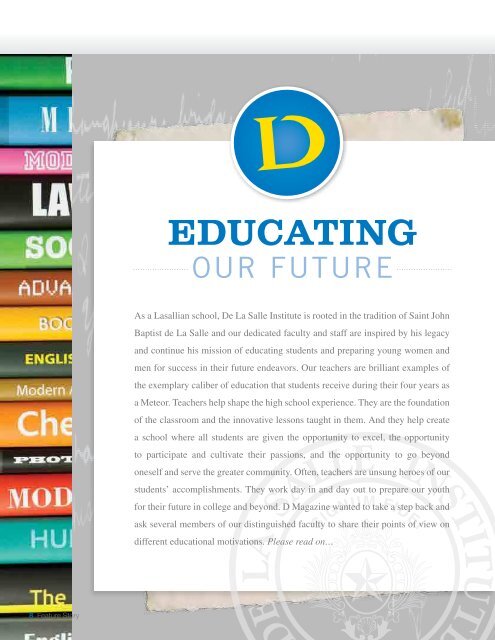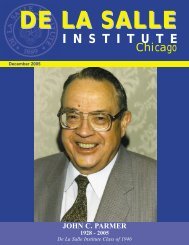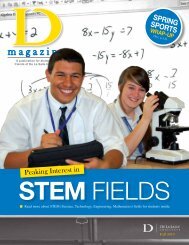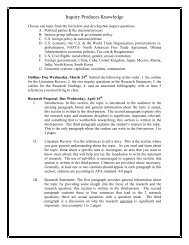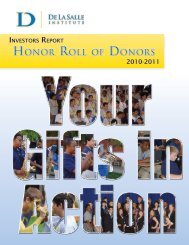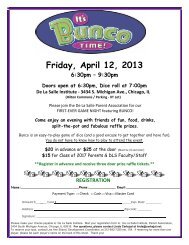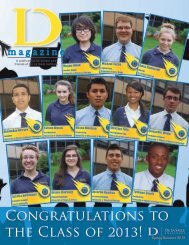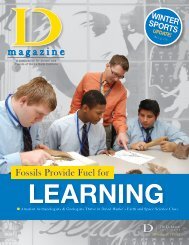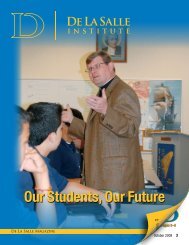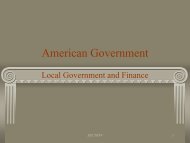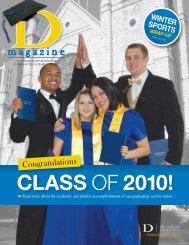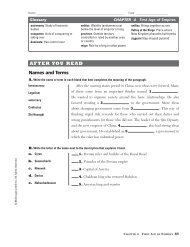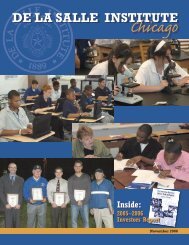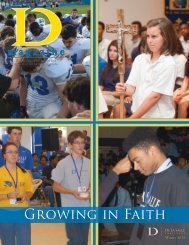Create successful ePaper yourself
Turn your PDF publications into a flip-book with our unique Google optimized e-Paper software.
Feature Story<br />
educating<br />
Our Future<br />
As a <strong>La</strong>sallian school, <strong>De</strong> <strong>La</strong> <strong>Salle</strong> <strong>Institute</strong> is rooted in the tradition of Saint John<br />
Baptist de <strong>La</strong> <strong>Salle</strong> and our dedicated faculty and staff are inspired by his legacy<br />
and continue his mission of educating students and preparing young women and<br />
men for success in their future endeavors. Our teachers are brilliant examples of<br />
the exemplary caliber of education that students receive during their four years as<br />
a Meteor. Teachers help shape the high school experience. They are the foundation<br />
of the classroom and the innovative lessons taught in them. And they help create<br />
a school where all students are given the opportunity to excel, the opportunity<br />
to participate and cultivate their passions, and the opportunity to go beyond<br />
oneself and serve the greater community. Often, teachers are unsung heroes of our<br />
students’ accomplishments. They work day in and day out to prepare our youth<br />
for their future in college and beyond. D Magazine wanted to take a step back and<br />
ask several members of our distinguished faculty to share their points of view on<br />
different educational motivations. Please read on…<br />
diane brown<br />
Principal, Lourdes Hall Campus<br />
In your more than 20 years of<br />
service, how has the vocation<br />
of teaching evolved<br />
Over the past thirty-four years, I have witnessed a paradigmatic shift in the academic environment from a teachercentered<br />
classroom to a student-centered classroom. When I began my teaching career in 1977, the classroom was a<br />
teacher-centered environment. The teacher delivered information through lectures, films, recordings, modeling<br />
exercises, and other techniques. Course notes were written on a blackboard, and tests were typed on Spirit Masters<br />
(typing paper with carbon attached) and duplicated on mimeograph machines since copy machines were scarce, and<br />
computers nonexistent. Students were expected to sit quietly and listen to the teacher, take notes, read, or follow<br />
whatever other directions they may have been given. Failure to do so could result in harsh punishment and dreaded<br />
phone calls home to parents. Teachers were expected to maintain complete control of the classroom environment, and<br />
students were more passive learners.<br />
Today’s classroom, however, is a student-centered environment. Although the expectations for educators to demonstrate<br />
academic expertise and effective classroom management strategies have not changed, teachers are now more challenged<br />
to engage students in active learning. This involves planning educational activities that teach to the whole child by<br />
taking into account the rich and diverse cultures, backgrounds, needs, and beliefs that students bring to the classrooms<br />
each day. In addition, educational tools for teaching have now been placed into the hands of students as tools for<br />
learning. Today, our students utilize state-of-the-art computer equipment for a variety of educational activities,<br />
including, but not limited to, studying electronic textbooks, taking notes, collaborating with classmates, communicating<br />
with teachers, creating presentations, and writing papers. More importantly, teachers and students are able to transcend<br />
the boundaries of the physical classroom by connecting to Internet sites that provide enriched learning opportunities<br />
never thought possible in 1977. Recently, I visited a social studies classroom in which students were viewing artifacts<br />
housed at the New York Museum of Fine Arts. Other classes have connected to university libraries to conduct research,<br />
have traveled across the globe to learn about foreign lands, have graphed and analyzed data from science experiments<br />
in class, and have sketched three-dimensional structures to better visualize complex structures. Students can engage in<br />
these and other educational activities via the Internet without ever leaving their classrooms. The possibilities for<br />
engaged learning opportunities are endless.<br />
8 Feature Story Feature Story 9


